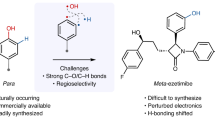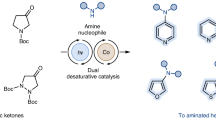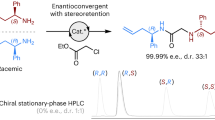Abstract
The mechanistic foundation behind the identity of a phosphine ligand that best promotes a desired reaction outcome is often non-intuitive, and thus has been addressed in numerous experimental and theoretical studies. In this work, multivariate correlations of reaction outcomes using 38 different phosphine ligands were combined with classic potentiometric analyses to study a Suzuki reaction, for which the site selectivity of oxidative addition is highly dependent on the nature of the phosphine. These studies shed light on the generality of hypotheses regarding the structural influence of different classes of phosphine ligands on the reaction mechanism(s), and deliver a methodology that should prove useful in future studies of phosphine ligands.
This is a preview of subscription content, access via your institution
Access options
Subscribe to this journal
Receive 12 print issues and online access
$259.00 per year
only $21.58 per issue
Buy this article
- Purchase on Springer Link
- Instant access to full article PDF
Prices may be subject to local taxes which are calculated during checkout





Similar content being viewed by others
References
Miyaura, N., Yamada, K. & Suzuki, A. A new stereospecific cross-coupling by the palladium-catalyzed reaction of 1-alkenylboranes with 1-alkenyl or 1-alkynyl halides. Tetrahedron Lett. 20, 3437–3440 (1979).
Wolfe, J. P., Wagaw, S. & Buchwald, S. L. An improved catalyst system for aromatic carbon−nitrogen bond formation: the possible involvement of bis(phosphine) palladium complexes as key intermediates. J. Am. Chem. Soc. 118, 7215–7216 (1996).
Driver, M. S. & Hartwig, J. F. A second-generation catalyst for aryl halide amination: mixed secondary amines from aryl halides and primary amines catalyzed by (DPPF)PdCl2. J. Am. Chem. Soc. 118, 7217–7218 (1996).
Knowles, W. S. & Sabacky, M. J. Catalytic asymmetric hydrogenation employing a soluble, optically active, rhodium complex. Chem. Commun. 1445–1446 (1968).
Strohmeier, W. & Müller, F.-J. Klassifizierung phosphorhaltiger Liganden in Metallcarbonyl-Derivaten nach der π-Acceptorstärke. Chem. Ber. 100, 2812–2821 (1967).
Tolman, C. A. Electron donor–acceptor properties of phosphorus ligands. Substituent additivity. J. Am. Chem. Soc. 92, 2953–2956 (1970).
Tolman, C. A. Phosphorus ligand exchange equilibriums on zerovalent nickel. Dominant role for steric effects. J. Am. Chem. Soc. 92, 2956–2965 (1970).
Tolman, C. A. Steric effects of phosphorus ligands in organometallic chemistry and homogeneous catalysis. Chem. Rev. 77, 313–348 (1977).
Lohan, M. et al. Synthesis, electrochemistry, spectroelectrochemistry, and solid-state structures of palladium biferrocenylphosphines and their use in C,C cross-coupling reactions. Organometallics 31, 2310–2326 (2012).
Lin, H.-J. et al. Steric and electronic control of the spin state in three-fold symmetric, four-coordinate iron(II) complexes. J. Am. Chem. Soc. 136, 13326–13332 (2014).
Kirchhoff, J. H., Dai, C. & Fu, G. C. A method for palladium-catalyzed cross-couplings of simple alkyl chlorides: Suzuki reactions catalyzed by [Pd2(dba)3]/PCy3 . Angew. Chem. Int. Ed. 41, 1945–1947 (2002).
Smith, J. M., Coville, N. J., Cook, L. M. & Boeyens, J. C. A. Steric parameters of conformationally flexible ligands from X-ray structural data. 1. P(OR)3 ligands in equivalent ligand environments. Organometallics 19, 5273–5280 (2000).
Chin, M., Durst, G. L., Head, S. R., Bock, P. L. & Mosbo, J. A. Molecular mechanics (MM2) calculations and cone angles of phosphine ligands. J. Organomet. Chem. 470, 73–85 (1994).
Hughes, R. P. et al. Syntheses and crystallographic studies of [Ir(η5-C5Me5)(L)(RF)I] (L = CO, PMe3; RF = CF2CF3, CF2CF2CF3, CF2C6F5, CF(CF3)2) complexes. Cone and solid angle steric parameters for perfluoroalkyl ligands. J. Chem. Soc. Dalton Trans. 873–880 (2000).
Bartik, T., Himmler, T., Schulte, H. G. & Seevogel, K. Substituenteneinflüsse auf die Basizität von Phosphorliganden in R3P-Ni(CO)3-komplexen. J. Organomet. Chem. 272, 29–41 (1984).
Mansson, R. A., Welsh, A. H., Fey, N. & Orpen, A. G. Statistical modeling of a ligand knowledge base. J. Chem. Inf. Model. 46, 2591–2600 (2006).
Golovin, M. N., Rahman, M. M., Belmonte, J. E. & Giering, W. P. Quantitative separation of σ- and π-components of transition metal–phosphorus bonding and the application of ligand effects in organometallic chemistry. Organometallics 4, 1981–1991 (1985).
Dunne, B. J., Morris, R. B. & Orpen, A. G. Structural systematics. Part 3. Geometry deformations in triphenylphosphine fragments: a test of bonding theories in phosphine complexes. J. Chem. Soc. Dalton Trans. 653–661 (1991).
Rahman, M. M., Liu, H. Y., Prock, A. & Giering, W. P. Quantitative analysis of ligand effects. 2. Steric and electronic factors influencing transition-metal–phosphorus(III) bonding. Organometallics 6, 650–658 (1987).
Brown, T. L. A molecular mechanics model of ligand effects. 3. A new measure of ligand steric effects. Inorg. Chem. 31, 1286–1294 (1992).
Fey, N. et al. Development of a ligand knowledge base, part 1: computational descriptors for phosphorus donor ligands. Chem. Eur. J. 12, 291–302 (2006).
Jover, J. et al. Expansion of the ligand knowledge base for monodentate P-donor ligands (LKB-P). Organometallics 29, 6245–6258 (2010).
Milo, A., Neel, A. J., Toste, F. D. & Sigman, M. S. A data-intensive approach to mechanistic elucidation applied to chiral anion catalysis. Science 347, 737–743 (2015).
Littke, A. F., Dai, C. & Fu, G. C. Versatile catalysts for the Suzuki cross-coupling of arylboronic acids with aryl and vinyl halides and triflates under mild conditions. J. Am. Chem. Soc. 122, 4020–4028 (2000).
Harper, K. C., Vilardi, S. C. & Sigman, M. S. Prediction of catalyst and substrate performance in the enantioselective propargylation of aliphatic ketones by a multidimensional model of steric effects. J. Am. Chem. Soc. 135, 2482–2485 (2013).
Milo, A., Bess, E. N. & Sigman, M. S. Interrogating selectivity in catalysis using molecular vibrations. Nature 507, 210–214 (2014).
Bess, E. N. et al. Analyzing site selectivity in Rh2(esp)2-catalyzed intermolecular C–H amination reactions. J. Am. Chem. Soc. 136, 5783–5789 (2014).
Bess, E. N., Bischoff, A. J. & Sigman, M. S. Designer substrate library for quantitative, predictive modeling of reaction performance. Proc. Natl Acad. Sci. 111, 14698–14703 (2014).
Mougel, V. et al. Quantitatively analyzing metathesis catalyst activity and structural features in silica-supported tungsten imido–alkylidene complexes. J. Am. Chem. Soc. 137, 6699–6704 (2015).
Zhang, C., Santiago, C. B., Kou, L. & Sigman, M. S. Alkenyl carbonyl derivatives in enantioselective redox relay Heck reactions: accessing α,β-unsaturated systems. J. Am. Chem. Soc. 137, 7290–7293 (2015).
Guzei, I. A. & Wendt, M. An improved method for the computation of ligand steric effects based on solid angles. Dalton Trans. 3991–3999 (2006).
Harper, K. C., Bess, E. N. & Sigman, M. S. Multidimensional steric parameters in the analysis of asymmetric catalytic reactions. Nature Chem. 4, 366–374 (2012).
Molecular Modeling Pro v. 6.36 (Norgwyn Montgomery Software Inc., 2012).
Verloop, A. Drug Design Vol. III (Academic Press, 1976).
Tebby, J. C. CRC Handbook of Phosphorus-31 Nuclear Magnetic Resonance Data (CRC Press, 1991).
Surry, D. S. & Buchwald, S. L. Dialkylbiaryl phosphines in Pd-catalyzed amination: a user's guide. Chem. Sci. 2, 27–50 (2011).
Schoenebeck, F. & Houk, K. N. Ligand-controlled regioselectivity in palladium-catalyzed cross coupling reactions. J. Am. Chem. Soc. 132, 2496–2497 (2010).
McMullin, C. L., Jover, J., Harvey, J. N. & Fey, N. Accurate modelling of Pd(0) + PhX oxidative addition kinetics. Dalton Trans. 39, 10833–10836 (2010).
Lyngvi, E., Sanhueza, I. A. & Schoenebeck, F. Dispersion makes the difference: bisligated transition states found for the oxidative addition of Pd(PtBu3)2 to Ar-OSO2R and dispersion-controlled chemoselectivity in reactions with Pd[P(iPr)(tBu2)]2 . Organometallics 34, 805–812 (2015).
Kozuch, S. & Martin, J. M. L. What makes for a bad catalytic cycle? A theoretical study on the Suzuki−Miyaura reaction within the energetic span model. ACS Catal. 1, 246–253 (2011).
McMullin, C. L., Fey, N. & Harvey, J. N. Computed ligand effects on the oxidative addition of phenyl halides to phosphine supported palladium(0) catalysts. Dalton Trans. 43, 13545–13556 (2014).
Kuhn, M. & Johnson, K. Applied Predictive Modeling (Springer, 2013).
Amatore, C., Jutand, A., Khalil, F., M'Barki, M. A. & Mottier, L. Rates and mechanisms of oxidative addition to zerovalent palladium complexes generated in situ from mixtures of Pd0(dba)2 and triphenylphosphine. Organometallics 12, 3168–3178 (1993).
Hartwig, J. F. & Paul, F. Oxidative addition of aryl bromide after dissociation of phosphine from a two-coordinate palladium(0) complex, bis(tri-o-tolylphosphine)palladium(0). J. Am. Chem. Soc. 117, 5373–5374 (1995).
Barder, T. E., Walker, S. D., Martinelli, J. R. & Buchwald, S. L. Catalysts for Suzuki−Miyaura coupling processes: scope and studies of the effect of ligand structure. J. Am. Chem. Soc. 127, 4685–4696 (2005).
Amatore, C. & Jutand, A. Role of dba in the reactivity of palladium(0) complexes generated in situ from mixtures of Pd(dba)2 and phosphines. Coord. Chem. Rev. 178–180(Part 1), 511–528 (1998).
Ito, N., Saji, T. & Aoyagui, S. Voltammetric studies of the metal–ligand interaction in low-valent metal-olefin π-complexes: Part I. [Pd(O)2(dibenzylideneacetone)3] and [Pt(O)2(dibenzylideneacetone)3]. J. Electroanal. Chem. Interfacial Electrochem. 144, 153–162 (1983).
Kurbangalieva, A., Carmichael, D., Hii, K. K., Jutand, A. & Brown, J. M. Oxidative addition to palladium(0) diphosphine complexes: observations of mechanistic complexity with iodobenzene as reactant. Chem. Eur. J. 20, 1116–1125 (2014).
Suzuki, K., Hori, Y., Nishikawa, T. & Kobayashi, T. A novel (2,2-diarylvinyl)phosphine/palladium catalyst for effective aromatic amination. Adv. Synth. Catal. 349, 2089–2091 (2007).
Allen, D. W. & Taylor, B. F. The chemistry of heteroarylphosphorus compounds. Part 15. Phosphorus-31 nuclear magnetic resonance studies of the donor properties of heteroarylphosphines towards selenium and platinum(II). J. Chem. Soc. Dalton Trans. 51–54 (1982).
Schrödinger Release 2014-3: MacroModel v. 10.5 (Schrödinger, 2014).
Gaussian 09, Revision D.01 (Gaussian, Inc., 2009).
MATLAB and Statistics Toolbox Release 2014a (The MathWorks, Inc., 2014).
Acknowledgements
This work was supported by the National Science Foundation (CHE-1361296). The support and resources from the Center for High Performance Computing at the University of Utah are gratefully acknowledged.
Author information
Authors and Affiliations
Contributions
Z.L.N., A.M. and M.S.S. conceived and designed the experiments; Z.L.N. performed the experiments; D.P.H. helped perform and analyse the electrochemical experiments; Z.L.N., A.M., D.P.H. and M.S.S. analysed the data; Z.L.N., A.M., D.P.H. and M.S.S. co-wrote the paper.
Corresponding author
Ethics declarations
Competing interests
The authors declare no competing financial interests.
Supplementary information
Supplementary information
Supplementary information (PDF 5039 kb)
Rights and permissions
About this article
Cite this article
Niemeyer, Z., Milo, A., Hickey, D. et al. Parameterization of phosphine ligands reveals mechanistic pathways and predicts reaction outcomes. Nature Chem 8, 610–617 (2016). https://doi.org/10.1038/nchem.2501
Received:
Accepted:
Published:
Issue Date:
DOI: https://doi.org/10.1038/nchem.2501
This article is cited by
-
Enantioselectivity prediction of pallada-electrocatalysed C–H activation using transition state knowledge in machine learning
Nature Synthesis (2023)
-
Data-science driven autonomous process optimization
Communications Chemistry (2021)
-
Stereoselectivity in Pd-catalysed cross-coupling reactions of enantioenriched nucleophiles
Nature Reviews Chemistry (2020)
-
Comparing quantitative prediction methods for the discovery of small-molecule chiral catalysts
Nature Reviews Chemistry (2018)
-
Quantifying ligand effects in high-oxidation-state metal catalysis
Nature Chemistry (2017)



